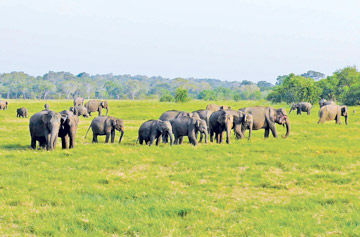Asian elephants are social networkers
Asian elephants have long been considered somewhat antisocial.
Instead of living in large, tightly knit herds, as do female elephants
on the African savanna, those in Asia were thought to have only small
groups of friends and few outside connections. But a new study shows
that many female Asian elephants are more like social butterflies, with
numerous pals. And they’re able to maintain strong friendships even with
those they have not seen in a year or more.
 The study adds Asian elephants to a short list of other species,
including dolphins, that are able to maintain complex social
relationships despite not having daily contact, an ability regarded as
being cognitively demanding. The study adds Asian elephants to a short list of other species,
including dolphins, that are able to maintain complex social
relationships despite not having daily contact, an ability regarded as
being cognitively demanding.
“People thought they knew what Asian elephants were doing [socially]
based on what they saw them doing in captivity,” says Shermin de Silva,
a behavioral ecologist with the Elephant, Forest and Environment
Conservation Trust in Colombo, Sri Lanka, and the lead author of the new
study. Asian elephants are also extremely difficult to study in the
wild, she adds. They inhabit dense forests, so researchers are usually
able to observe the animals only by climbing tall trees or watching them
when they gather at water holes.
But 30 years ago, one population of Asian elephants on Sri Lanka
became observable because it lost its forest home. People logged the
trees, converted the land into teak plantations, and subsequently dammed
the region’s main river, creating the large Uda Walawe reservoir. In
1972, 308 square kilometers around the reservoir were made into the
Udawalawe National Park. Some 800 to 1200 former forest elephants now
live here on grass- and scrublands that resemble an East African
savanna, de Silva says.
The open landscape made it possible for de Silva and her team to
identify 286 individual adult female Asian elephants, they report in the
current issue ofáBMC Ecology.
The researchers then tracked the social relationships of 51 of these
elephants over a 2-year period. Almost immediately, de Silva realized
thatáthe elephants had larger social networks than previously
recognized. Adult females she saw hanging together one day were often
not together the next but were with other individuals.
“It was said that Asian elephants usually had only three friends” and
loose associations with others, implying an unstable social structure,
de Silva says. “But we found they can have 10 or more; some even have 50
friends,” de Silva says, adding that these are not random associations.
The scientists identified the elephants’ “friends” or “companions” as
those individuals within 500 meters of one another who were moving,
resting, or sharing resources. Those females with the most friends
tended to be unfaithful pals, often dropping elephants that the
researchers thought were their five “best friends forever” for a new
set. Those with the fewest number of friends proved to be the most
loyal. How genetically related these adult elephants are is not known
but will be investigated in a future study, the researchers say.
Although some Asian elephants may not see certain companions for long
stretches of timeùmore than a year in some casesùthey are probably in
touch in other ways, de Silva says, becauseáelephants can communicate
both chemically and acoustically over long distances. “The ‘herd’ one
sees at any given time is often only a fragment of a much larger social
group.”
The researchers’ statistical analysis of the elephants’ relationships
shows that female Asian elephants live in a highly dynamic and fluid
society, with individuals leaving and rejoining, much as chimpanzees and
bottlenose dolphins are known to do. “Elephants showed their tightest
bonds during the dry season,” de Silva says. When water resources are
scarce, some elephant friends would team up to drive others they did not
know away from pools.
“It’s an intriguing study on two fronts,” says George Wittemyer, a
wildlife biologist at Colorado State University, Fort Collins. “First,
it provides the basic socioecology of a high profile but surprisingly
poorly studied species.” And second, “it describes a relatively unique
social system” that can be understood only by observing it for several
years. “It’s fascinating,” adds Phyllis Lee, a behavioral ecologist at
the University of Stirling in the United Kingdom and a member of the
Amboseli Elephant Research Project. “The question becomes how do they
maintain these relationships,” because what the elephants are doing
“requires a high level of cognitive capacity,” as any social networking
maven well knows.
Science Now
|

